How To Choose A Drum Kit
Congratulations! You're making the first step in getting your first set of Drums...
Considering the thrilling journey of learning the drums? It certainly packs tonnes of excitement, and we’ve crafted this straightforward guide just for newcomers. This series offers a roadmap to steer you in the right direction from the get-go.
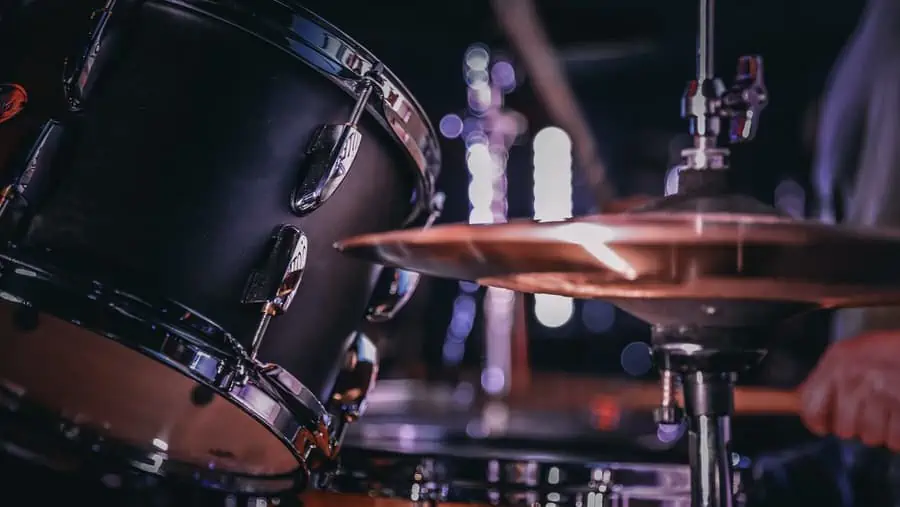
Things you should know before buying your first Drum Kit
To decide what drum kit is best, you’ll need to think about what you intend to do with it. Now, I know you’ll be thinking “what a stupid thing to say! I intend to play it!”, but choosing a musical instrument is based on a series of choices that include:
- What sort of budget do you have? Remember, as with most things in life; you get what you pay for – so try to have the largest budget you can afford
- What type of music do you want to play? Do you want to release your inner Neil Peart and play the drum kit with 30 tom-toms and 25 cymbals??
- What space will the instrument be going in? Probably the most important question as a drummer, and to stay friends with your neighbours and housemates!
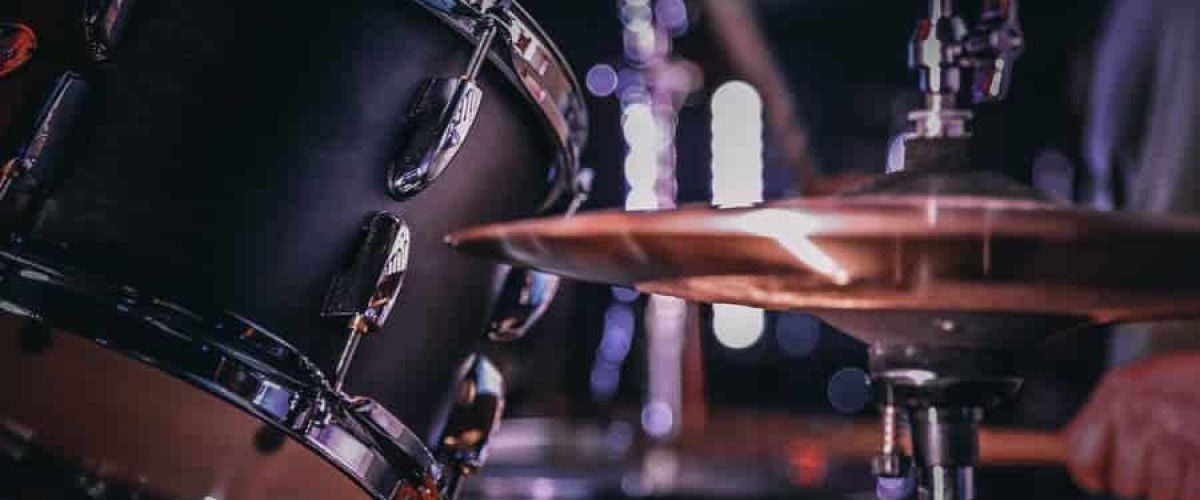
Types of Drum Kits
Acoustic

Acoustic simply means the big, loud ‘real’ drums, usually made out of wood and metal that you would traditionally see being played by a drummer in a band. They are hollow cylinders with skins stretched across, called heads, that you hit with a stick.
Electronic
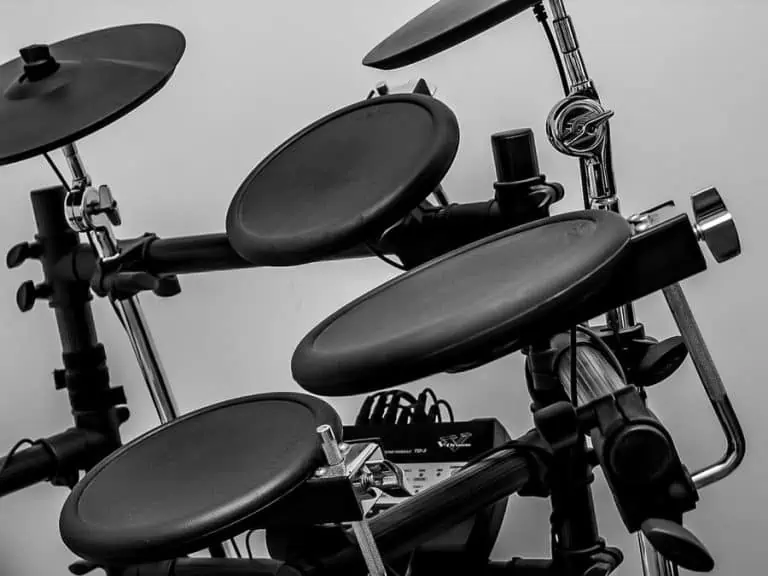
Electronic has the exact same layout as the Acoustic kit but instead of having a hollow drum, it just has a rubber or mesh pad only a couple of inches deep that you hit.
Electronic Drum Kits are plugged into an amplifier (similar to how an Electric Guitar would be) or can be just listened to through headphones. They are sometimes used on stage by electronic dance acts because they offer up a range of different drum sounds, but they are most popular for practice because they are considerably quieter than Acoustic drums.
Electronic or Acoustic? Which one is right for you?
To put it bluntly, it comes down to how loudly you are able to play wherever you plan on setting up your kit.
If you live in an apartment or a house share and have no soundproofing in place, I would strongly recommend an Electronic Drum Kit (unless you have unusually understanding housemates and neighbours!). This isn’t just about keeping others happy; you have to be comfortable hitting the drums quite hard. If you try and practice quietly you are going to get pretty fatigued as soon as you play on stage for a performance.
Remember – practice doesn’t count – only GOOD practice!
If you are fortunate enough to have space where making noise isn’t an issue (such as a garage or studio), I would recommend getting an Acoustic Drum Kit. The feel and diversity of the sounds you can make on real cymbals and drums can’t quite be matched by even the most expensive top of the range Electronic Drum Kits (although some at the very top are getting close).
What types of Drum Kits are there and how many drums should I buy?
A standard Drum Kit is considered to be a ‘five-piece’ kit, comprising of a snare drum, bass drum and three drums called tom-toms or just toms; two mounted above the bass drum and a third with its own legs.
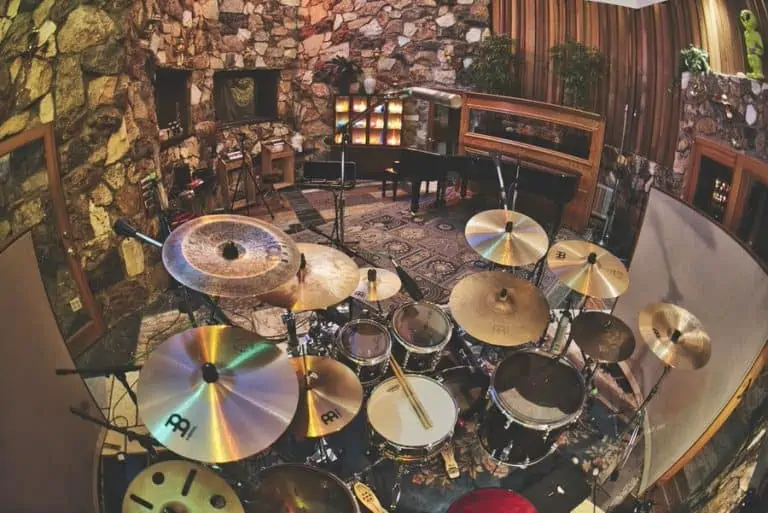
Snare Drum
Bass Drum
Tom-toms
cymbals
Snare Drum
A snare drum is the one you will find yourself probably playing the most. This drum originated in the army and can be very loud! They are usually very shallow and have a top white surface which is called a batter head as this is the side that you hit. If you turn it over, you will see there is a transparent head on the bottom with curly metal wires running across. These are the ‘snares’ and they vibrate against the bottom, or snare head, to create a unique buzzing sound when the batter head is struck. Weirdly, you don’t actually ever hit this head.
There will be a lever on the side of the drum to raise and lower the snares against the head which will turn the buzzing on and off. When buying a kit make sure that this action is smooth, not loose or corroded and stays on when you want it on, and off when you want it off.
Bass Drum
A bass drum is the biggest drum on the kit and sits on its side so that the head can be played by a foot pedal. (With the right foot for right-handed players and with the left foot for left-handed players.)
Tom-toms
Tom-toms can be large or small, are hit with a stick and are usually played during drum fills. (For anyone that watches the British TV show Eastenders, they are the drums played at the beginning of that iconic theme music!)
cymbals
A basic cymbal set up is a pair of hi-hats (they always come as a pair and are sandwiched together and played either with your sticks or your left foot pedal), a crash and a ride cymbal.
The ride cymbal is the biggest of the cymbals and goes on the opposite side of the drum kit to your hi-hats.
This is the set up you would purchase on virtually every Electronic kit on the market, and for most Acoustic kits too.
It‘s also common to only have two toms on an Acoustic kit rather than three. However, if you have the opportunity to buy a three tom-tom set rather than just two it’s certainly worth investing in the extra tom because it’ll be much harder and more expensive to buy one further down the line.
For left-handed players, all drum kits can be simply set up as the mirror image of a right-handed kit. You won’t need to buy anything specifically left-handed, unlike a guitar.
I should probably mention here that cymbals aren’t usually included when buying Acoustic drum kits unless they’re sold as all-inclusive beginner sets, but they should come as standard when buying Electronic kits.
Don’t forget to buy a seat!
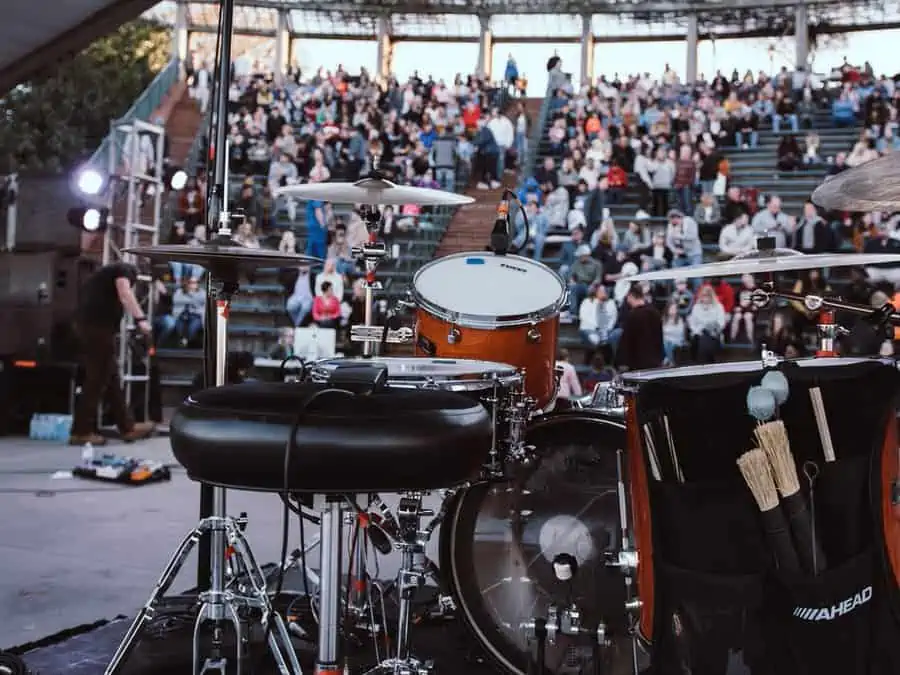
Drum seats are called stools or thrones and can vary greatly. Make sure when buying one that you can vary the height of it to suit your playing and that it isn’t wobbly or feels unstable. It must be able to twist with your body so unfortunately, you can’t just use any old chair. If you think about it, that is the part of the kit that you use the most. Using an unsuitable chair can lead to posture and even serious back problems so it’s worth making sure yours feels comfortable.
If you are looking to expand your kit, popular add ons are an extra cymbal (such as a second crash, china or a splash cymbal), usually positioned above the ride cymbal, a cowbell (the black or chrome hollow metal block hit with a stick) and an extra floor tom. But this can be extended to tambourines and other effects attached to the top of the hi-hat, extra toms, extra snare drums, and a myriad of diverse cymbals and drums. You are only limited by your imagination and space available!
But could you imagine setting this up for a gig..?!
Different types of Acoustic drum kits
As you progress with your playing and performing on the drums, you will have preferences to the types of music you enjoy playing and how you want your drums to sound.
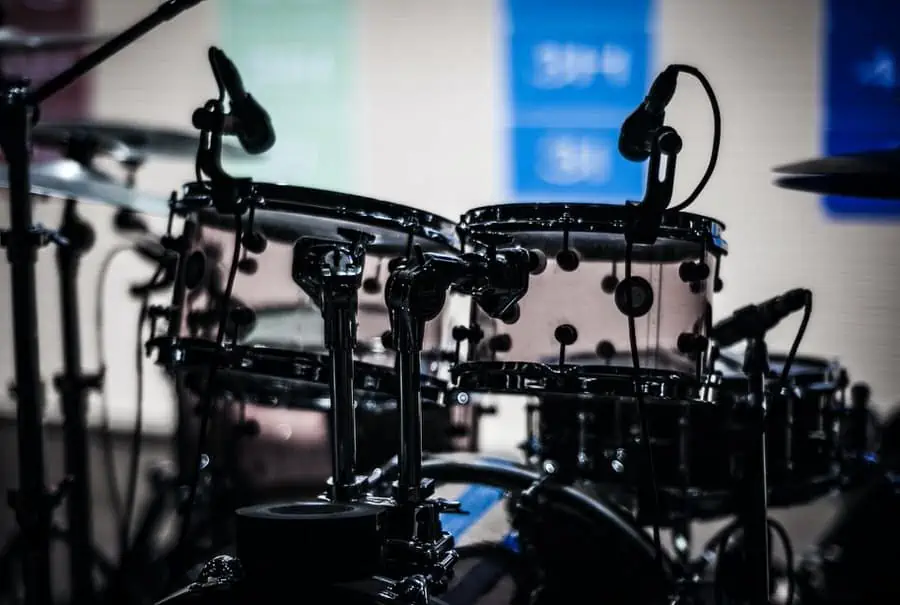
Heavy Rock and Metal
For heavy rock and metal, bigger really is better. You’ll probably want a 22”, or even 24” bass drum and a snare drum at least 5.5” deep. The toms would probably be 12”, 13 or 14” and 16” diameter. (Because it is still the standard measurement in the USA, drums and cymbals are always referred to in inches.)
If you like the sound of the super-fast bass drumming usually featured in heavy metal and fusion music, investing in a double bass drum pedal is far easier than trying to fit in a second bass drum within your kit. This is a fairly advanced technique and although it sounds awesome, it shouldn’t be a substitute for being able to play fast with your main bass drum foot.
The toms should have transparent heads on, sometimes with a black ring around the outside (called a pinstripe) and offer a lot of resonance, but they won’t be tuned as tightly as the snare drum head, so the stick won’t bounce back as much.
Jazz
For jazz and more mellow music drummers, an 18” bass drum is preferable with usually only two tom-toms – an 8, 10 or 12” mounted tom, and a floor tom.
Jazz players usually prefer white drum heads, called coated heads, and generally are tuned higher than for metal or rock.
If you are just starting out, or play a range of styles of music, I would recommend a five-piece kit with the following sizes; a 14” snare, 20 or 22” bass drum, 10”, 12” and 14” tom-toms. This is sometimes referred to as a fusion kit, although it’s rapidly just considered the standard kit sizes now.
Types of Electronic Drum Kit
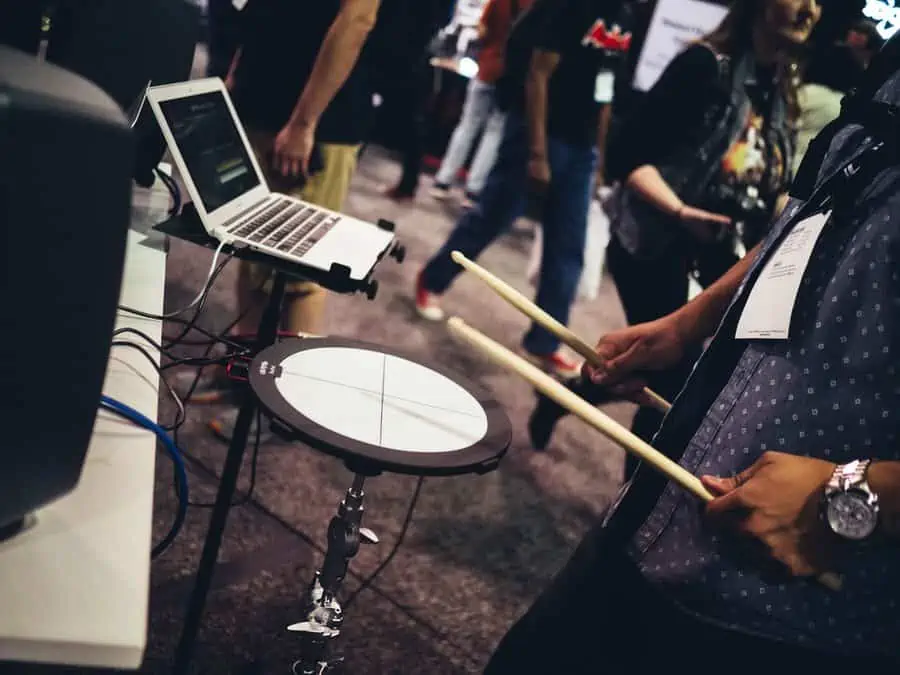
Just the same as it is with any technology, the more you can afford, the better the kit will be. The original brand in the market is Roland, and it is still by far the market leader. However, there are several newer brands that have been making great strides in progress over the last few years at the lower budget end of things, including Alesis and Yamaha.
If you are buying an Electronic Drum Kit just to get started at home, you probably don’t need the most famous brand and would be better off saving that money to invest in your first drum upgrade down the line.
When you look at an Electronic Drum Kit, you will notice that the sizes are probably smaller, and the heads are either black rubber or a black or white mesh. In terms of feeling like you’re playing ‘real’ drums, the white mesh heads are far preferable; the rubber heads are very bouncy and it can feel a little too easy to play as the stick will bounce back a lot more than it would on an Acoustic drum. If you can afford it, get a kit with at least a mesh snare drum head as that is the drum you will be playing the most.
Don’t worry that the heads are smaller than Acoustic drums – they will just make you more accurate when you come to an Acoustic kit!
Things to be aware of when buying a drum kit
Regardless of which type of drum kit you purchase, you should be aware of whether you are buying a complete kit, a shell pack, or if it includes hardware.
The shell pack means it is quite literally the drums – or the ‘shells’. They should have heads on them but that would be it.
This kit appears to be a complete kit but be careful – it will only come as the drums without everything else.
The ‘hardware’ is the metal stands that the drums and cymbals are mounted on to so you can play them. If buying a kit that says “hardware included” find out if this includes the stands for just the drums, or the cymbals as well.
A complete starter kit should include all of the above as well as a bass drum pedal, stool and maybe even a pair of sticks thrown in so you can literally set it up and play straight out of the box.
Second-hand buying tips
If buying second hand, don’t worry too much if the heads have lots of dents in and need to be replaced. This is one of the cheapest ways to transform a drums sound, and something you should do when buying a new kit anyway (as there will probably be cheap standard heads on a new kit). Think of it as the difference in performance you get after changing the tyres on a car.
More important than the conditions of the heads is looking for rust and damage to the drums themselves. A drum with a crack in it is worthless as it can’t really be repaired, and unless its a snare drum or extra tom-tom you weren’t going to use anyway, it will probably be more expensive to replace the drum after buying the kit.
How To Choose A Drum Kit - Summary
One of the delights of the drums is the variety of sizes, finishes, woods, setups and accessories that are available to you. Few instruments offer the same opportunities to personalise to the player and so every drum kit – and drummer – is unique. You can always add extra accessories as your playing develops.
Have a play on as many different kits as you can, ask questions to drummers you admire and check out videos online of drummers and bands you enjoy.
Drums needn’t be an expensive instrument to take up and there is something for every budget and age. In fact, drums have actually come down in price and up in quality over the years. Generally, if you know you need to play quietly buy an electronic kit, but if you are able to make as much noise as you like, buy an acoustic kit. Aim for a kit with five drums, a crash, ride and hi-hat cymbals and you will be set up for almost everything.
Enjoy making your kit your own!
About the Author
Robert Emery
Robert Emery is Founder & CEO of Ted's List. He has performed all around the world as a conductor and pianist. From Sydney Opera House to the Royal Albert Hall, Robert has enjoyed bouncing around on stage in most of the major venues in the world. As a record producer, he has worked on fifteen No 1 albums, and hopes he can get to sixteen asap!
The Times called him 'the eccentric barefooted maestro' and the Mail quoted that 'the assured baton was controlled by the rather energetic and brilliant conductor'.
Robert has a wife (Mrs. E), two children (Master T and Master A) and four cats (Merlin, Mulberry, Partridge & Penguin). Between performing, producing, composing and running Ted's List, he runs an entertainment business called The Arts Group, comprising of a symphony orchestra, choir, live event production house, digital TV company and artist agency. Any spare time is usually devoted to sleep.
Other posts by this author
Every Friday, I personally Deliver This Exclusive Email…
4-Feature Friday does what it says on the tin; sends you an email every Friday with four of the most outstanding things I’ve found that week
The email really could be about anything; ebooks, audio, tracks, gadgets, training tricks – as long as it’s pleasurable and interesting and terrific, it’ll finish up on the email!
Get easy access now by clicking below.
Read the next post in this series:




